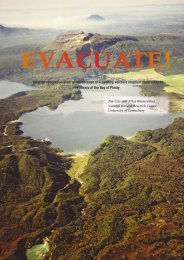Download Tephra Volume 23 (PDF, 1.33MB) - Ministry of Civil ...
Download Tephra Volume 23 (PDF, 1.33MB) - Ministry of Civil ...
Download Tephra Volume 23 (PDF, 1.33MB) - Ministry of Civil ...
Create successful ePaper yourself
Turn your PDF publications into a flip-book with our unique Google optimized e-Paper software.
Mobilising for Resilience: From<br />
Government to Governance<br />
Robert L. Bach<br />
Resilient communities adapt through creating innovative<br />
approaches to collective governance, seising unexpected opportunities<br />
to decide for themselves how to respond, organising to work with<br />
government agencies in new ways, and accepting both the promise and<br />
responsibility <strong>of</strong> joint decision-making.<br />
Throughout much <strong>of</strong> the world, national leaders have<br />
realised that in preparing for, responding to, and recovering<br />
from disasters, government agencies and programmes<br />
cannot do it alone. Local communities are increasingly<br />
recognised as a critical partner in their nations’ resilience.<br />
In this changing world, the challenge for<br />
governments is to learn and design ways to best support<br />
these local activities, especially in situations when the<br />
government is not in control. Top-down managerial and<br />
even logistics frameworks fail to mobilise and incorporate<br />
the knowledge, access, resources, coordination, and<br />
commitment <strong>of</strong> the broadest sectors <strong>of</strong> local communities.<br />
A new whole-<strong>of</strong>-community approach is called for, but<br />
governments with their very different organisational shapes<br />
and authorities do not yet seem to know how to work as<br />
supporters <strong>of</strong> local communities rather than as authorities,<br />
directors and agenda-setters over subordinate entities and<br />
clients.<br />
The Multinational Resilience Policy Group<br />
In 2009, a group <strong>of</strong> senior policy leaders from<br />
several countries organised themselves into an informal<br />
working group to examine this central transformational<br />
issue. They decided to examine real life practices <strong>of</strong><br />
communities (acting in vastly different national contexts)<br />
in the face <strong>of</strong> various natural and manmade hazards. The<br />
central question involved a “how to” inquiry, seeking first<br />
to understand the value <strong>of</strong> community engagement and<br />
empowerment, and then increasingly to identify a range <strong>of</strong><br />
potential governance arrangements and experiences that<br />
successfully support local community resilience.<br />
This article highlights a few issues explored in this<br />
continuing policy leadership discussion. They are selected<br />
out <strong>of</strong> an expanding array <strong>of</strong> case stories constructed<br />
locally by a combination <strong>of</strong> practitioners, researchers, and<br />
community members who have survived disastrous events<br />
<strong>of</strong> both large and modest scale. Common themes that<br />
influence community resilience have emerged from these<br />
policy leaders’ engagement with local communities in over<br />
ten countries. These include:<br />
• the nature <strong>of</strong> communities<br />
• state-civil society relationships<br />
• social capital and social trust-leadership<br />
• meaningful exchange.<br />
The group has selected a dozen <strong>of</strong> these case<br />
stories to assemble into an edited volume. For purposes<br />
here, the focus is primarily on governance activities that<br />
help illuminate how public decisions are made before,<br />
during and after crisis events - that is, on “state and civil<br />
society relations”. 1 How does government work to build<br />
the relationships and institutions that enable and strengthen<br />
the capability and capacity <strong>of</strong> local communities to resist<br />
disasters, respond effectively, and recover to levels <strong>of</strong> wellbeing<br />
above those that existed before the emergency?<br />
Partnering with the ‘right’ groups<br />
One <strong>of</strong> the most difficult challenges for government leaders,<br />
especially those from national departments and agencies,<br />
is to understand community complexities throughout the<br />
cycle <strong>of</strong> emergency planning, preparedness, response and<br />
recovery. The perceived natural partners for government<br />
are <strong>of</strong>ten the established community institutions that have<br />
developed to provide both non-emergency and emergency<br />
services to local residents. Governments are comfortable<br />
with these organisations because they have administered<br />
government programmes and funds before, and there is<br />
a presumption that their legacy attests to familiarity and<br />
1 The case stories mentioned in this article are fully presented<br />
in the Policy Group’s forthcoming edited volume. The authors <strong>of</strong> the case<br />
stories have presented them to the Policy Group at various conferences or<br />
provided draft versions <strong>of</strong> chapters to be included in the volume. The author<br />
<strong>of</strong> the present article is solely responsible for the interpretation <strong>of</strong> these<br />
stories presented here. His views do not necessarily represent those <strong>of</strong> the<br />
authors <strong>of</strong> the final versions <strong>of</strong> each case story. Contact with the authors <strong>of</strong><br />
each case story before the volume is published may be arranged through this<br />
author at rbach20010@aol.com.<br />
36

















